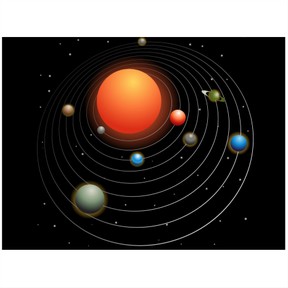
Solar system patterns
I can identify and explain the different patterns in the sky.



8,000 schools use Gynzy
92,000 teachers use Gynzy
1,600,000 students use Gynzy
General
Students learn about solar system patterns of the sun, moon, and stars.
Standards
NGSS: 1-ESS1-1
Learning objective
Students will be able to identify and explain different patterns in the sky including the sun, moon, and stars.
Introduction
Ask students to do a turn and talk exercise in which they discuss what they see when they look up into the sky during the day. Repeat this but then have them do this discussing what they see when they look up into the sky at night. As a class, discuss the different things that they have come up with for both turn and talk moments, and then complete the Venn diagram to compare night and day.
Instruction
Tell students that we have night and day because the Earth makes a rotation in 24 hours in which it rotates. This rotation causes light to shine on about half of the planet while the other half is dark. Explain that the sun rises in the east and sets in the west because the Earth rotates to the east. Ask if anything would change if you lived on a different part of the planet. Ask students to think about where the sun is in the sky when they come to school and when they leave to go home. Is it in the same place? Why might it be in a different spot in the sky? Teach students that the seasons change because of the earth's orbit around the sun. Remind students that some parts of the earth (like the equator) are closer to the sun no matter what time of year it is, and as a result, have milder (or no) seasons at all! Explain to students that a full orbit of the sun takes 365 days, or one year. Ask students why the seasons might be opposite to the USA in Australia. Now have students do a turn and talk about the moon. What do they know about the moon? Discuss their answers and then tell more about the moon and how it orbits. Explain that the light of the sun causes the moon to glow and that the position of the earth causes the moon to appear in different shapes. Go through the phases of the moon with the students. Ask which phase of the moon they like best. Show a diagram with the sun, moon, and earth and ask what phase the moon would be in according to this diagram.
Quiz
Students are first given a set of true/false questions to check their knowledge of key concepts from the lesson. They are then asked to fill in the blanks in the sentences given with keywords from the lesson.
Closing
Remind students that they can now identify and explain different patterns in the sky, including the sun, moon, and stars. Ask students to name an instance in which they see the orbit of the sun, earth, or moon. To close the lesson, you can choose to either engineer a sundial or create shadow friends. Follow instructions as given on the interactive whiteboard.
Instruction materials
Optional materials:
For Sundial: paper pate, pencil/pen, markers, tape, glue stick, paper clock face
For Shadow friends: chart paper, marker
The online teaching platform for interactive whiteboards and displays in schools
Save time building lessons
Manage the classroom more efficiently
Increase student engagement
Discover more!
About Gynzy
Gynzy is an online teaching platform for interactive whiteboards and displays in schools.
With a focus on elementary education, Gynzy’s Whiteboard, digital tools, and activities make it easy for teachers to save time building lessons, increase student engagement, and make classroom management more efficient.



